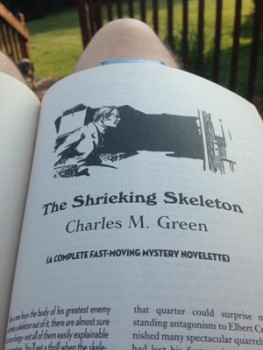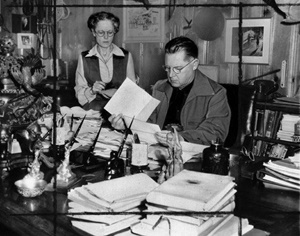A (Black) Gat in the Hand: Erle Stanley Gardner’s “The Shrieking Skeleton”
 Even the best-selling Erle Stanley Gardner struggled to break into the better markets early in his career. Of these early days, Gardner said, “I wrote the worst stories that ever hit New York City. I have the word of an editor for that, and he hadn’t seen the worst stories because the worst ones I wrote under a pen name.”
Even the best-selling Erle Stanley Gardner struggled to break into the better markets early in his career. Of these early days, Gardner said, “I wrote the worst stories that ever hit New York City. I have the word of an editor for that, and he hadn’t seen the worst stories because the worst ones I wrote under a pen name.”
Gardner sold his first two stories to Breezy Stories and they were published in 1921. Then we have this bit of fun…
In 1923, under the name of Charles M. Green, he submitted a novelette, “The Shrieking Skeleton” to The Black Mask (‘The’ was dropped for the May, 1927 issue). Gardner said that “It was a major opus as far as I was concerned, and looking back on it, I guess it must have been a dilly.” George Sutton was the editor at this time. While Joseph ‘Cap’ Shaw is given credit for making Black Mask the leading institution of the hardboiled school, Sutton published the first detective stories of Carroll John Daly and Dashiell Hammett and was at the helm when Race Williams and The Continental Op debuted. He played a big part in the development of the genre.
Upon receipt of the story, somebody thought it was so bad, they sent it on to circulation editor Phil Cody (who would succeed Sutton as editor). They told him it was to be the lead story and they wanted a publicity campaign to promote it. Oh, those scamps!
Cody blew his top and sent it back to the editorial department. He wrote that the story gave him a pain in his neck and it was pretty near the last word in childishness. The characters talked like dictionaries and the so-called plot had whiskers on it like unto Spanish moss hanging from a live oak in a Louisiana bayou (???). He foresaw the end from the beginning and the story was puerile, trite, obvious and unnatural. He begged that the story not be used.
The joke having succeeded, the story was sent back to Gardner with the usual rejection slip (which Gardner was receiving by the dozens). The slip stated that just because the story was returned, it did not necessarily imply that there was any lack of literary merit, it simply did not fit in the schedule. Gardner (who later became good friends with Cody) knows this because Cody’s note was inadvertently included with the returned manuscript.
The story also relates that there was a letter from George Sutton to Gardner, referencing Cody’s ‘vitriolic remarks,’ but also containing some encouraging words and suggestions and telling the writer that if he edited, cut and revised the story, they would be glad to review it again.
If the letter was included with the returned manuscript, I don’t see how Cody’s comments were accidentally included since Sutton referenced them. But that’s not important, I guess.
This marked the first time Gardner had received editorial feedback with a rejection and he quickly sent a thank you letter to Cody. It included:
‘I also wish to send my thanks to your Circulation Manager, whose pencil note accompanied your letter. There is something genuine and human about his exasperation, and he expresses himself so much to the point that I have chuckled over it all day, in spite of the fact that I am the target for his remarks. I have been in the law game long enough to keenly appreciate the fellow who can “hand me one”; and any man capable of registering so much disgust on so little paper is an artist.
I am going to try to revise this story so it will “get under his skin” and wish you would try it out on him when I resubmit it.’
Now, I have to think that when he first read Cody’s comments, he wasn’t exactly grateful and quite so magnanimous. Then, he listed out the stories deficiencies, covering just about everything but the title. Then, as he says, “I was up just about all night for three nights hammering away at the thing.”
“My typewriter didn’t have rubber keys. The technique that I had was a two-fingered technique which caused the pounding on the hard typewriter keys to pull the flesh at the ends of my fingers away from the fingernails. I got to splattering blood on the typewriter keys, so I covered the ends of my business fingers with adhesive tape and kept right on hammering away.”
Wow.
Of the completely reworked story, he later said, It “was a pretty mediocre story. It was amateurishly written.” But he mailed it off to Sutton who sent back a $160 check. Gardner was in Black Mask, with only his third published story!
 The story is very much in the ‘shudder pulps’ mode. Before becoming a bastion of hardboiledness, Black Mask published quite a few of those types of tales, as well as a lot of westerns. It’s told in the first person by Walter XX, a lawyer invited by his mentor and financial sponsor, Alfred Potter, to spend a week’s vacation at the latter’s country home.
The story is very much in the ‘shudder pulps’ mode. Before becoming a bastion of hardboiledness, Black Mask published quite a few of those types of tales, as well as a lot of westerns. It’s told in the first person by Walter XX, a lawyer invited by his mentor and financial sponsor, Alfred Potter, to spend a week’s vacation at the latter’s country home.
Oh: and Potter has the skeleton of his nemesis, the late Elbert Crothers, hanging on the door in his home laboratory/workroom!
A cousin of Crothers wrote a letter to Potter, saying he’s heard from the beyond and if Potter does not give the remains a decent burial, he’ll regret it. And…an unearthly, horrifying shrieking sound seems to be coming out of the skeleton. Potter, who studies spiritism, is intrigued, rather than scared.
Somebody is killed – apparently by the skeleton. I’ll let you read the story for the rest. I’m not all that enthused about it, though the action picks up in the denouement. And remember: it’s only Gardner’s third story!
But the story behind the story is worth telling.
As a bonus, here’s a rejection letter which Gardner received a bit later from Harry C. North at Black Mask:
Dear Mr. Gardner:
This is terrible.
Sincerely
H.C. North
Associate Editor
Ouch!
Previous entries in the series:
With a (Black) Gat: George Harmon Coxe
With a (Black) Gat: Raoul Whitfield
With a (Black) Gat: Some Hard Boiled Anthologies
With a (Black) Gat: Frederick Nebel’s Donahue
A (Black) Gat in the Hand: Thomas Walsh
A (Black) Gat in the Hand: Black Mask – January, 1935
A (Black) Gat in the hand: Norbert Davis’ Ben Shaley
A (Black) Gat in the Hand: D.L. Champion’s Rex Sackler
A (Black) Gat in the Hand: Dime Detective – August, 1939
A (Black) Gat in the Hand: Back Deck Pulp #1
A (Black) Gat in the Hand: W.T. Ballard’s Bill Lennox
A (Black) Gat in the Hand: Day Keene
A (Black) Gat in the Hand: Black Mask – October, 1933
A (Black) Gat in the Hand: Back Deck Pulp #2
A (Black) Gat in the Hand: Black Mask – Spring, 2017
A (Black) Gat in the Hand: Frank Schildiner on Max Allen Collins’ Nate Heller (Next Week)
Other hard-boiled related ramblings I’ve done at Black Gate:
A Century of John D. MacDonald
A Man Called Spade
Asimov’s The Caves of Steel
Carroll John Daly & the Birth of Hard Boiled
Cool & Lam are Back!
Erle Stanley Gardner on Mysteries
Gideon Lowry – Key West Private Eye
Glen Cook’s Garret – PI
Hard Boiled Holmes (my best pre-Black Gate work. Click on over!)
Hard Case Crime Q&A
John D. MacDonald – A Writer’s Writer
Lester Dent’s Master Plot Formula
The Maltese Falcon in Film
Michael Stone’s Streeter
Richard Diamond – Private Eye
Robert E. Howard Goes Hard boiled (Steve Harrison)
Shovel’s Painful Predicament
Bob Byrne’s A (Black) Gat in the Hand appears weekly every Monday morning at Black Gate.
His ‘The Public Life of Sherlock Holmes’ column ran every Monday morning at Black Gate from March 2014 through March 2017 (still making an occasional return appearance!). He also organized Black Gate’s award-nominated ‘Discovering Robert E. Howard’ series.
He is a member of the Praed Street Irregulars, founded www.SolarPons.com (the only website dedicated to the ‘Sherlock Holmes of Praed Street’) and blogs about Holmes and other mystery matters at Almost Holmes.
He has contributed stories to The MX Book of New Sherlock Holmes Stories – Parts III, IV, V and VI.
And coming soon, look for another Robert E. Howard series with an all star cast!